Guitar part names

Introduction
Much like a doctor should know the anatomy of the human body, a guitarist should know the anatomy of the guitar, whether it be for the purposes of fixing, learning, or even just talking about your instrument more easily.

How Is It Helpful to Know Your Guitar’s Anatomy?
For instance, if your guitar has a crack in its nut, you’ll be able to research solutions for that much easier by knowing what the nut of the guitar is, and its purpose.
Also, if you’re learning how to tune your guitar, you’ll be able to follow along more intuitively upon reading instructions to twist the guitar’s tuning peg, if you know where the tuning peg is located.

As you can see, by understanding the names of the guitar’s parts, your ability to communicate with others, whether it’s your guitar tech or your guitar teacher, is greatly enhanced, which is important for aspects such as your learning speed.
Do You Need to Know All the Guitar Part Names?
Though, it’s worthwhile to mention that, as a guitar player – and not a guitar builder – you don’t necessarily have to overwhelm yourself by learning every miniscule part of the guitar.

Instead, the general overview of parts in the remainder of this article should suffice for your foundational guitar anatomy knowledge.
No items found.
Glossary of the Guitar’s Anatomy
Take some time to acquaint yourself with the important parts of the guitar, outlined below. Doing so, you’ll build that foundational vocabulary for the guitar’s parts, and be better prepared for the upcoming 12 week, beginner to intermediate guitar course!
The order of the parts will proceed from the top-down on the guitar.
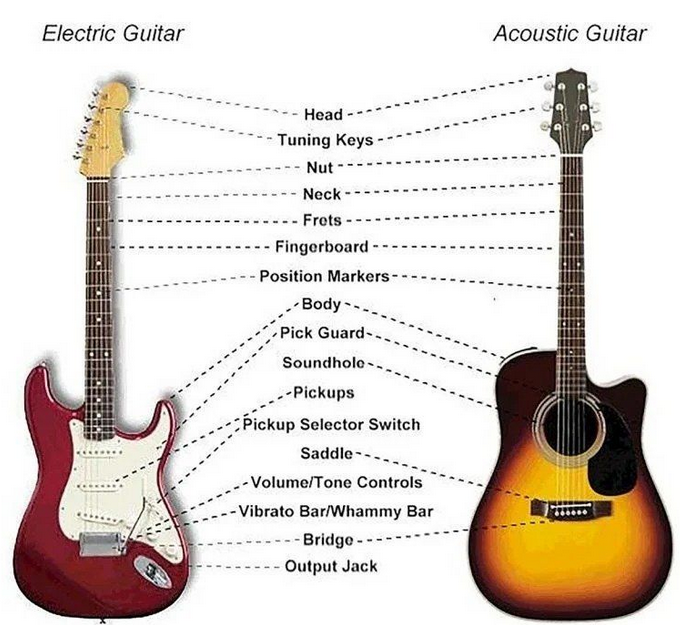
Headstock
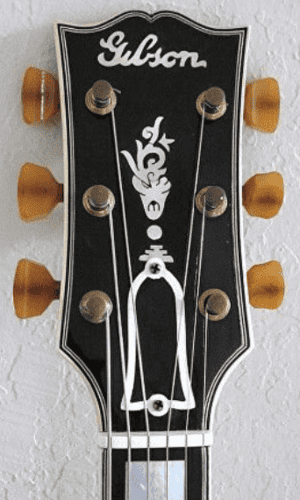
At the top of your guitar is the guitar’s headstock. It houses the tuning pegs, access point for your guitar’s truss rod (if it has one), and its branding. They can come in many different shapes, angles, and sizes depending on the make and model of your guitar.
Tuners

Also known as tuning keys, tuning pegs, or machine heads, your tuners are how you increase or decrease string tension (and, thus, pitch) on your guitar. The rotating keys act as worm gears which connect to pinion gears; the pinion gears, in turn, rotate the tuning pegs, thereby tightening or loosening the strings, which alters their pitch.
Nut
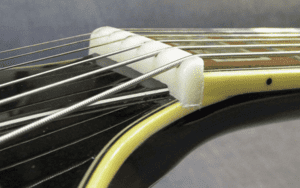
The nut is the starting point of your strings’ vibrational span when plucked, usually made of plastic or bone. Small notches allow the strings to be properly spaced from each other, and set at their proper heights above the fretboard.
Neck
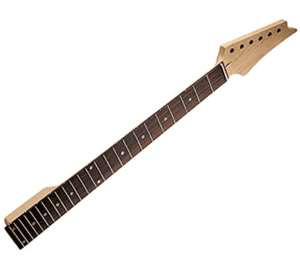
The neck of the guitar is the length of wood connecting your guitar’s headstock and body. It contains the fretboard, frets, and truss rod. Typically, necks are connected to the body via some combination of a dovetail joint, bolts, and/or glue. Necks come in various “neck profiles”, such as a C, D, or V profile (denoting the shape of their curvature when grasped by your fretting hand), and various thicknesses, depending on the desires of the guitarist.
Fretboard

Typically made of harder woods such as rosewood, maple, or ebony (helping to prevent dents or warping), the fretboard is a separate piece of wood, laid upon the neck, which houses the frets. It usually has decorative inlays of plastic or mother-of-pearl, as well as subtle fret markers on its side, denoting different lengths of the fretboard. The fretboard is sometimes also called the fingerboard.
Frets
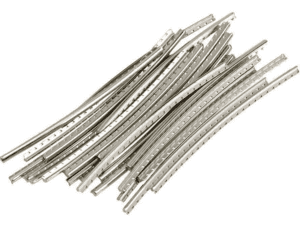
Frets are the metal strips which lay parallel to each other along the fretboard’s length. They allow you to alter the strings’ pitches by “stopping”, or “fretting”, the strings at different points along the fretboard, which temporarily decreases their vibrational span, thereby altering the strings’ pitches. They typically come in various sizes, from thin to jumbo; jumbo frets are usually easier to play, though they can be more cumbersome for intricate guitar styles.
Truss Rod
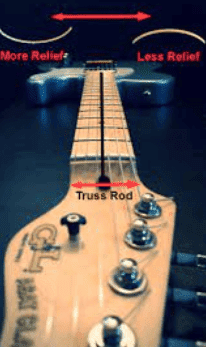
Acting as a metal reinforcement through the neck, a truss rod is like a spinal cord for the neck, lying beneath the fretboard. It helps to stabilize the guitar’s neck from bowing, due to excess string pressure, and can be tightened or loosened to fix inward or outward neck bowing. Note that truss rods should be adjusted with extreme care (preferably with an experienced player or a luthier only), since they can potentially snap your guitar’s neck if misadjusted.
Body

For acoustic and electric guitars, the body of the guitar yields much of the tonal qualities, based on the selection and age of woods, and the type of build. Whereas electric guitars are usually built from either solid slab of wood or laminate wood (thin slices of wood pressed together), acoustic guitars are built of from a top, sides, and back, glued and bound together; the top of an acoustic guitar is the face with its soundhole, the sides give the guitar its depth, and the back of the guitar is the side of the body without the soundhole which presses into your stomach as your play the guitar.
Cutaway
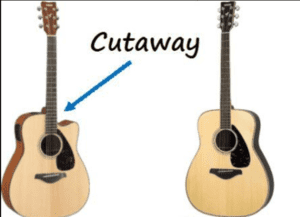
A cutaway on a guitar is ironically actually the lack of a part of the guitar! It’s the empty, scooped portion of the guitar’s body which is absent so it’s easier to access the topmost frets of the neck. They’re more common in electric guitars, since there’s a greater tendency to use an electric guitar for solos and other lead melodic lines, which often involve higher-pitched notes, though they’re quite common on acoustic guitars too.
Soundhole
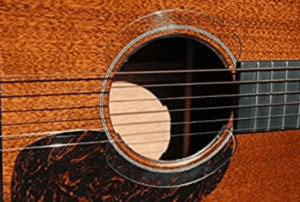
For an acoustic guitar, and archtop electric guitars, the soundhole(s) is the opening from which the acoustic properties of the instrument are better projected through the air. In truth, the entire body of the guitar helps with sound emanation, though the soundhole acts as a nice “escape valve”, to quote another article, for vibrating the air. They can come in different shapes, such as the normal circular shape, the traditional f-holes similar to violins, or other artistic shapes.
Rosette

The rosette is the ornamental, often concentric pattern which sometimes decorates an acoustic guitar’s soundhole.
Pickguard
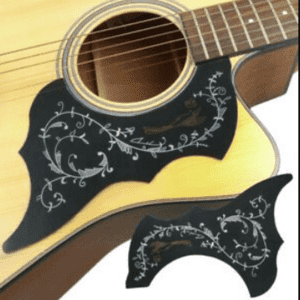
Often present on a guitar is the pickguard. Caught up in the fire of musical moments, guitarists can sometimes strum so aggressively that their pick strokes actually make contact with the guitar’s body, leaving scratches. Thus, the pickguard is there to protect the guitar’s body, and is usually made of plastic, pearloid, other woods, or acrylics.
Bridge
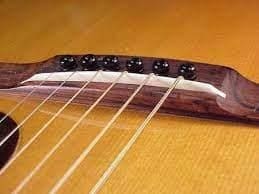
The bridge of the guitar helps to transmit the vibration of the strings to the guitar’s body, and houses the saddle, which also helps with that sound conduction. The bridge of an acoustic guitar is usually made of wood, and for an electric guitar it’s usually made of steel, brass, or titanium.
Saddle
As the nut of the guitar marks the beginning of the strings’ resonant lengths, the saddle marks the end. Again often made of hard plastic or bone for acoustic guitars, the saddle supports the strings and helps to conduct their resonance to the guitar’s body. Also, the saddle helps to set the height of the strings (also called the string “action”); on electric guitars, the saddle usually has an adjustable height and is usually made of steel, brass, or titanium, similar to their bridge.
Bridge Pins
For a steel-stringed acoustic guitar, the bridge pins are small pieces of synthetics, bone, or plastic, which anchor the end of the strings into the guitar’s body. They’re driven into the body like a wedge to hold in place, though they shouldn’t be driven in too heavily (otherwise the bridge can crack due to the stress), though they shouldn’t be too loose (in case they get yanked out by the tension of the strings).
Pickups
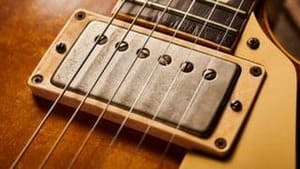
This is mainly for electric guitars, though it can apply to acoustic guitars as well. Thanks to physics, pickups create a magnetic field above the strings, within which the strings vibrate; the disturbance of the vibrating strings induces a voltage, which is then transferred to your guitar’s amplifier via a patch cable. Note that for acoustic guitars, the physical mechanism of the pickups can be a bit different, since there are a few different styles of acoustic pickups.
Pickup Selector Switch
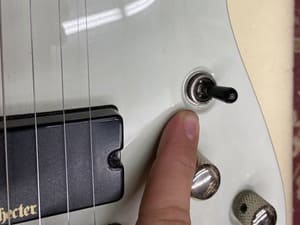
Again, this is more for electric guitars. If you’ve got more than one pickup, you can select which pickup to be activated, and, due to the nature of where the pickup is located relative to the bridge, the selector switch allows you to have greater tonal control of the guitar. Some guitars like Stratocasters allow you to have two active pickups at the same time, which expands the tonal ranges you can achieve.
Volume & Tone Knobs
The volume and tone knobs of your electric guitar are controlled by potentiometers, which are much like a dimmer knob for your lamp. Adjusting the “dimness” of your volume pot controls how loud or quiet your volume is, and adjusting the “dimness” of your tone pot controls how bright or dark your tone is. It usually takes some playing around to find what volume and tone settings you should use to match your desired sound qualities.
Output Jack
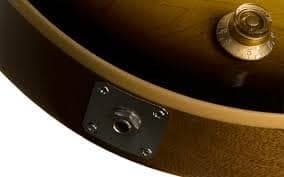
This is where you can connect your guitar, using a ¼” patch cord, to an amplifier, pedalboard, mixer, or recording interface. Depending on the make and model of the guitar, it can have different locations.
Strap Buttons
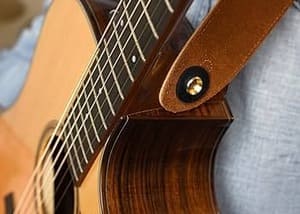
Finally, the strap buttons of your guitar allow you to attach a strap to your guitar, so you can play while standing (or more comfortably while sitting).
Know that it’s extremely easy for straps to accidentally come loose, resulting in your guitar falling to the ground and breaking! Therefore, you should definitely think about upgrading your strap buttons so they stably lock the strap, mitigating your risk of dropping the guitar.